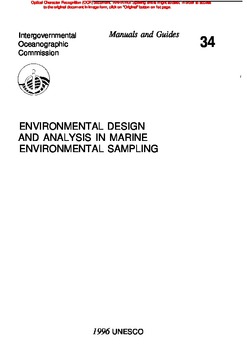| dc.contributor.author | Underwood, A.J. | en_US |
| dc.date.accessioned | 2014-02-24T15:24:15Z | |
| dc.date.available | 2014-02-24T15:24:15Z | |
| dc.date.issued | 1996 | en_US |
| dc.identifier.citation | Underwood, A.J. (1996) Environmental design and analysis in marine environmental sampling. Paris, France, UNESCO, 93pp. (Intergovernmental Oceanographic Commission Manuals and Guides; 34). DOI: https://doi.org/10.25607/OBP-1427 | |
| dc.identifier.uri | http://hdl.handle.net/11329/161 | |
| dc.identifier.uri | https://doi.org/10.25607/OBP-1427 | |
| dc.description.abstract | The IOC-IMO-UNEP/GIPME Groups of Experts on Effects of Pollution (GEEP) has been working for a number of years on promoting new ways of understanding how pollutants affect marine biological systems. A major initial focus of GEEP was on calibration workshops where different methods were tested against one another. The Oslo (1986), Bermuda (1988) and Bremerhaven (1992) workshop publications are widely regarded as benchmarks demonstrating that biological effects
methods are reliable tools for measurement of the effects of pollutants discharged to the marine
environment. IOC through GEEP, in cooperation with UNEP, has published a series of manuals based on the successful techniques and these are listed at the back of this volume.
Monitoring programmes for chemical contamination and for biological effects of these contaminants are used globally. Yet often the sampling design of such programmes has received little attention. Monitoring programmes are often conducted in order to be able to tell politicians and managers whether or not the quality of a given sea area is improving or getting worse. More often than not the answer, frequently after many years of measurement, is that the trends are difficult to detect. It is no exaggeration to say that countless millions of dollars are wasted in poor sampling design where there is no possibility of getting the answers to the questions posed by the managers and politicians.
Sampling design is a key but neglected aspect of chemical and biological effects monitoring. In this manual, GEEP Vice Chairman, Professor A.J. Underwood of the University of Sydney gives a clear and important account of the key elements of good sampling design, It is our hope that this
manual will help change the way that managers and scientists consider their monitoring programmes and that there will be a radical change in sampling design as a consequence. | en |
| dc.language.iso | en | en_US |
| dc.publisher | UNESCO for IODE | en_US |
| dc.relation.ispartofseries | Intergovernmental Oceanographic Commission Manuals and Guides; 34 | en |
| dc.subject.classification | Marine environment | en_US |
| dc.title | Environmental design and analysis in marine environmental sampling. | en |
| dc.type | Report | en_US |
| dc.description.version | check with Chair (Pierre Daniel) Marine Accident Emergency Support (MAES) | |
| dc.description.status | Published | en |
| dc.format.pages | 93pp. | en_US |
| dc.description.other | Environment variables, marine environmental sampling, marine environmental design, variability in measurement, statsical tests, analysis of variance, factorial designs, logarithms, environmental disturbance | en_US |
| dc.subject.asfa | Environmental monitoring | en |
| dc.subject.asfa | Environment management | en |
| dc.subject.asfa | Variability | en |
| dc.subject.asfa | Marine environment | en |
| dc.subject.asfa | Measurement | en |
| dc.subject.agrovoc | Environmental monitoring | en |
| dc.subject.agrovoc | Marine environment | en |
| dc.subject.agrovoc | Measurement | en |
| dc.description.notes | Professor A.J. Underwood
Institute of Marine Ecology
Marine Ecology Laboratories All
University of Sydney
NSW 2006, Australia | en_US |
| dc.publisher.place | Paris, France | |
 Repository of community practices in Ocean Research, Applications and Data/Information Management
Repository of community practices in Ocean Research, Applications and Data/Information Management
